Hello everybody on Out of Games. Welcome to a new recurring column on our platform that we've all been planning for a while, Retrospective (get it?), which takes a deeper look at some older games, exploring their history, what earned them their place in the gaming world back then and how they feel to play today.
Our first Retrospective entry takes a look at the original Sonic the Hedgehog, released in 1991 for the Sega Genesis (also known as the Mega Drive outside of the United States, but for the sake of brevity, I'm going to be solely referring to it as the Genesis.) Sonic is one of the longest-standing gaming franchises of all time and features one of the most iconic characters in all of media, so I thought it was only appropriate that we hopped into this series with the origin of a franchise that holds such high significance to gaming. With the franchise's 32nd anniversary just a few weeks ago (with Sonic Origins Plus being released) and Sonic Superstars on the horizon, there's no better time to look at the roots of the blue furball than now.
Sonic in History
The world of gaming in 1991 was obviously very different than it is today, not just in terms of the games themselves and their technical characteristics, but also their companies. At this point, Nintendo was dominating the gaming market as pretty much the only "huge" player in the industry. The Nintendo Entertainment System released in 1983 established the brand as leaders of the industry, accompanied by the Super Mario and Donkey Kong franchises around the same time. That same year, the infamous video game crash happened, and Nintendo had basically revitalized the industry.
The Sega Genesis had already existed for three years by the time 1991 rolled around. This was when Sonic the Hedgehog entered the fray as a competitor for Mario and also during the time when the two companies were more heated rivals than they are now. You may be familiar with the old slogan, "Genesis does what Nintendon't" as the company's way to advertise that their console was better than Nintendo's, but Sega would eventually fall behind in the race when the Sega Saturn ended up failing in sales compared to the Nintendo 64 and the Sony PlayStation. Sega would eventually leave the console business when their final console, the Dreamcast, despite being fondly remembered for a number of good titles, came up short financially.
But while Sega may have ended up with the short end of the stick in terms of the console wars at the time, they continue to be widely popular and are registering healthy sales. Sonic the Hedgehog, to this day, remains a vastly popular franchise that's still kicking, and although it's had a very rocky path with many ups and downs over its entire lifespan, it still continues to move and find some success. The Murder of Sonic the Hedgehog, released as an April Fools joke earlier this year has been legitimately well received.
What else was happening in 1991? In terms of video games anyway, 1991 was also the year Capcom released Street Fighter II, which resulted in a huge surge to the fighting game genre's popularity as we know it today. The SNES released in North America that year. The Legend of Zelda: A Link to the Past was released in Japan, and Sid Meier's Civilization first struck the ground that year as well.
The decade in general was also when platformers of all sizes were leaving their mark on the industry. In addition to the fact that Mario and Sonic were still very much alive and kicking around this time, the 1990s also gave us Rayman, Banjo-Kazooie, Crash Bandicoot, and Spyro the Dragon.
Gameplay
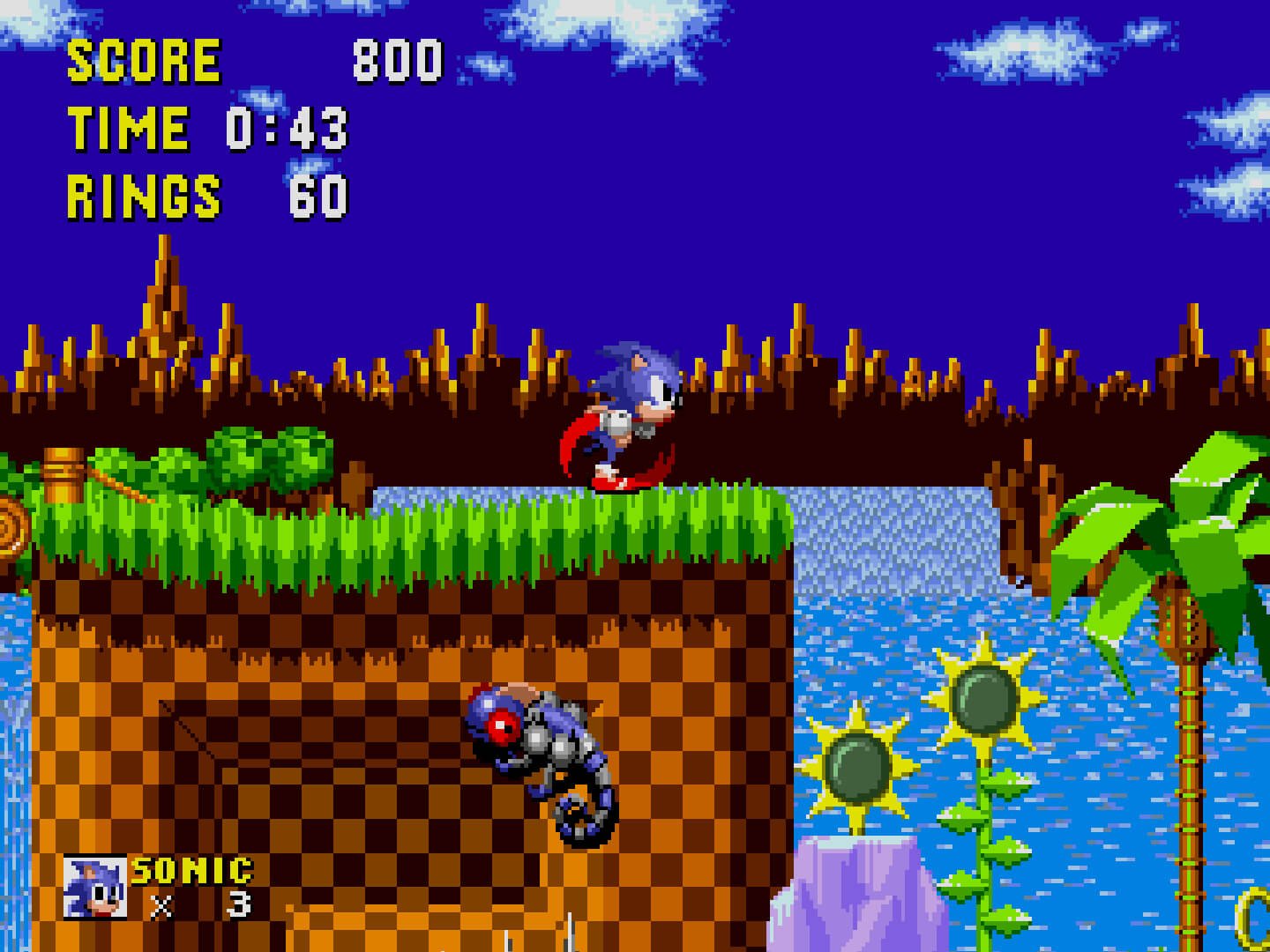
Ah, Green Hill Zone. One of the earliest examples of the first level being the "green" level.
I must admit that explaining how Sonic games work feels a bit weird since I imagine almost every person who has ever played a video game before is at the very least aware of Sonic's existence and the basics of how it plays. But in the event that someone who is unaware of the basic premise manages to stumble upon this article, let me explain.
What might be surprising to those people is that the basics of Sonic have largely stayed the same over the course of 30 years. Some things get added, but most of the design pillars introduced in this first installment still apply to the series as a whole.
The movement of Sonic is very momentum-oriented. While Sonic has always been about speed, I feel like the classic Sonic games in particular have always been more about momentum, and this is further reflected by the fact that Sonic doesn't immediately start running at top speed as soon as you tell him to move forward. He has to pick up that speed first. Sonic is probably one of the first games to have proper incline programming on the movement, and this is something you can take advantage of with the rolling attack by pressing down while moving. In this state, he's pretty much just a victim to inertia.
Sonic can attack with this rolling move too, but his main method of attacking is by jumping, whereby he will curl into a ball (except in very specific circumstances presumably due to a bug) and hit enemies he damages while in ball form (with the classic jumping sound effect that is still in use to this very day). While moving around, he will also collect rings and the game will play the iconic ring sound effect when you grab one (which is also still in use throughout the franchise to this day).
Rings actually function as Sonic's health. As long as he has at least one ring when he takes damage, he won't die and those rings will scatter around (and Sonic is able to pick them back up). If he takes damage without any rings, he will die (assuming he doesn't have a shield). Sonic can jump on monitors (essentially boxes with pre-determined rewards) which can range from anything including 10 rings, a shield to keep him safe from one hit, speed shoes to make him move faster (and this will also speed up the music during the time this is active), sparkles to make Sonic invincible for a brief period of time (accompanied with its own jingle) and a Sonic monitor that grants an extra life.
The top-left of the screen tells you your score, timer, and ring count. If you manage to keep hold of 100 rings, you'll earn an extra life. Stages do have a time limit of 9:59 and if you exceed that, you will die and lose a life, but all of the stages are way too short for that to realistically happen without doing it on purpose. Your score counter will go up by defeating enemies and some bonuses at the end of a level, but score in this game serves no purpose other than being a number that ticks up. At the bottom-left is your life count. Along the way, Sonic will also run into posts with blue spheres on top that turn red when touched. These are checkpoints which produce a satisfying "be-doo" sound effect when touched (which, once again, is a sound effect the franchise still uses even now).
You can also press up and down on the d-pad/keyboard to look up or down, which is not really needed for any particular purpose.
The game has six full length Zones and a final Zone which basically serves as the final boss fight of the game. Each Zone, except for the final Zone, have 3 Acts which all share the same visual elements and music (Scrap Brain Zone being a minor exception since it uses a different background for all 3 of its Acts).
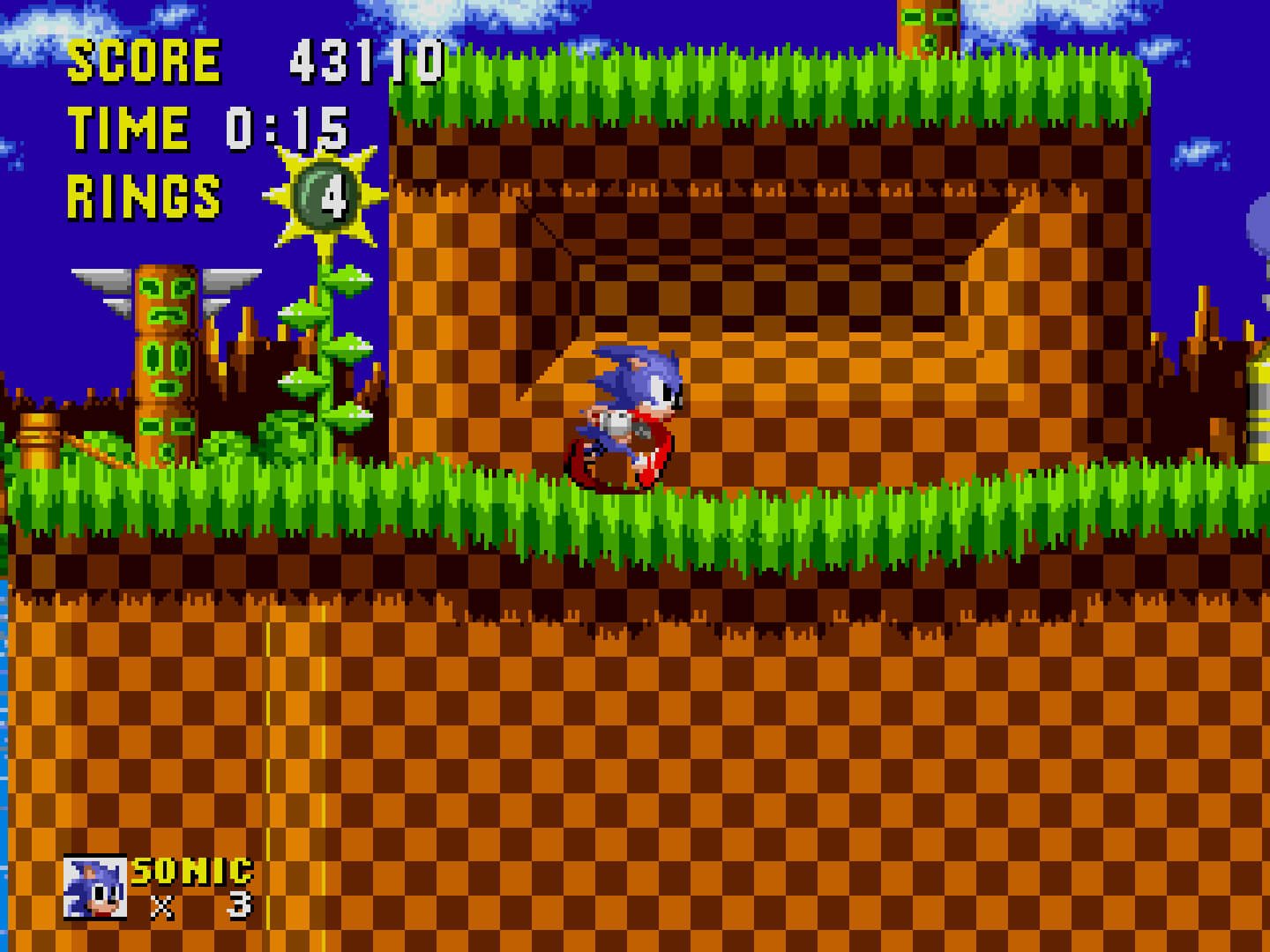
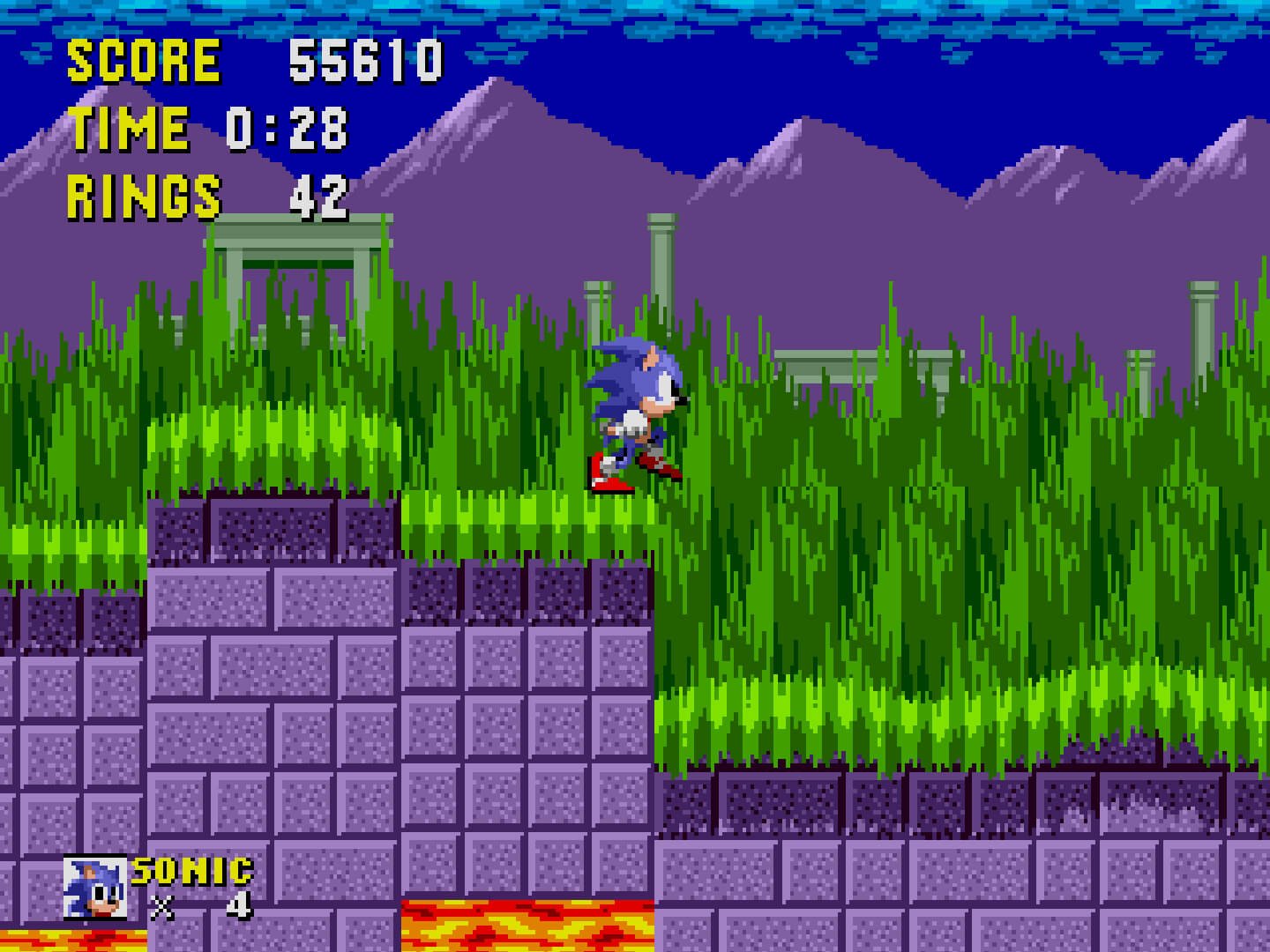
Left = Green Hill Zone
Right = Marble Zone
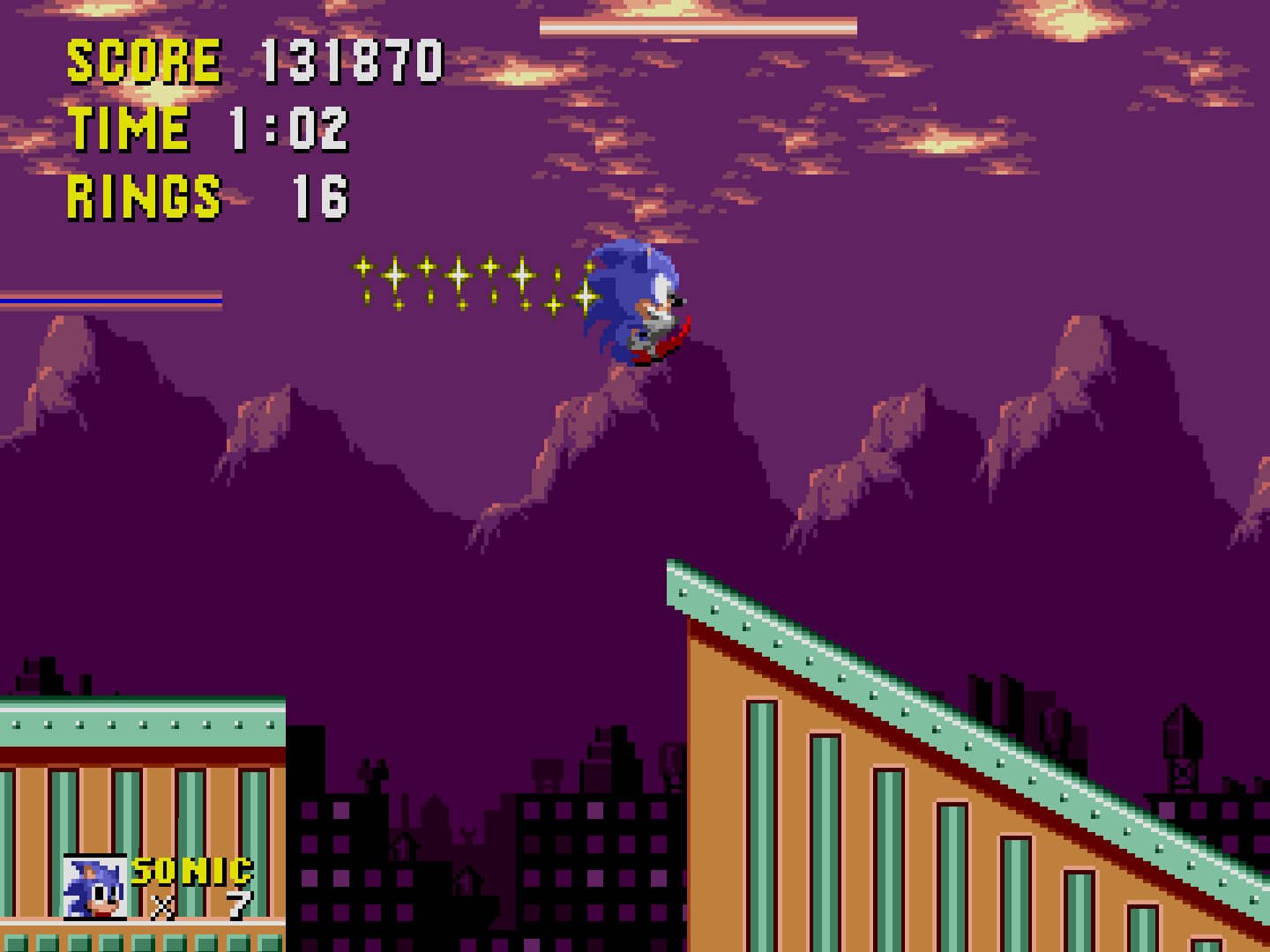
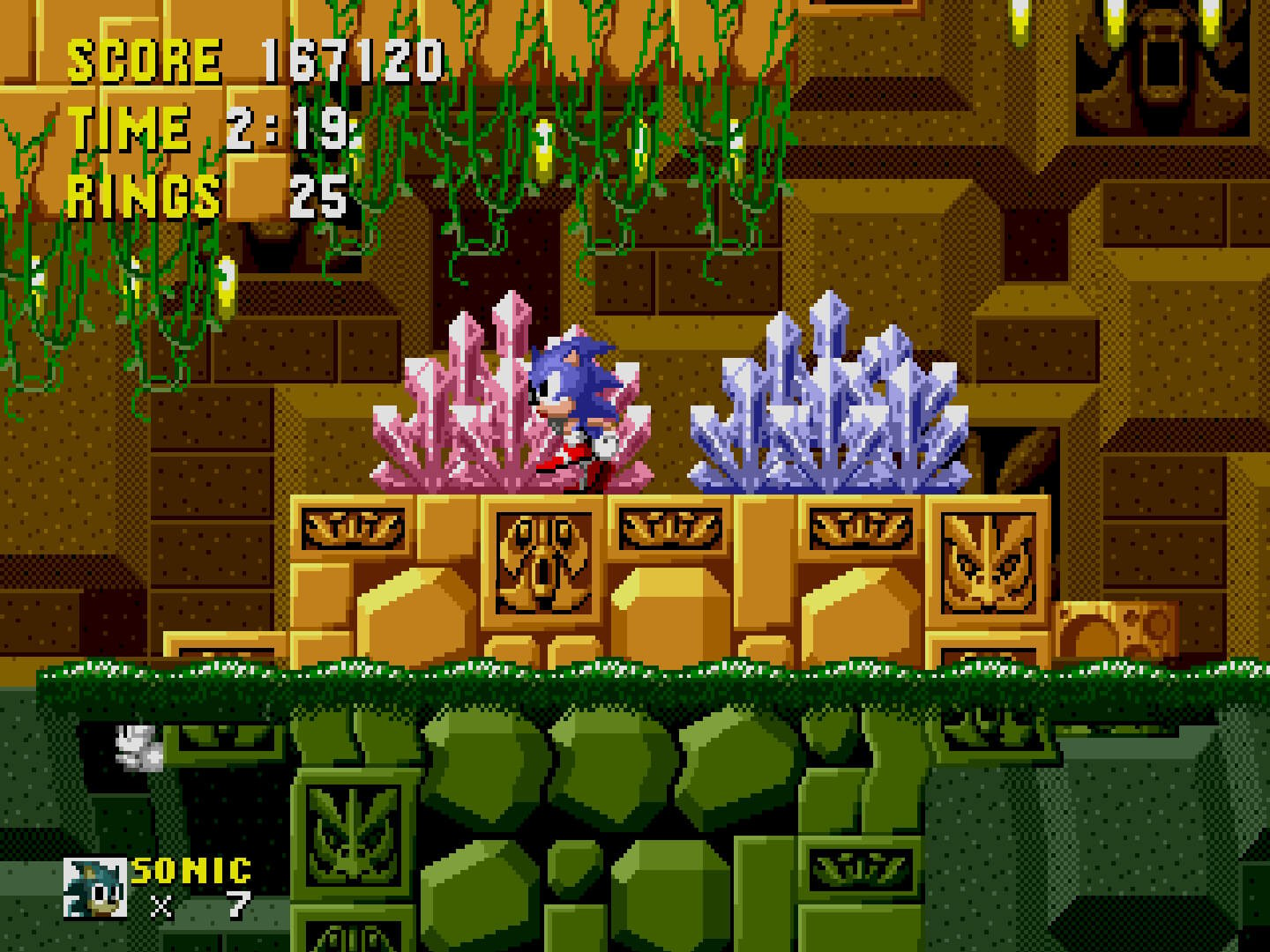
Left = Spring Yard Zone
Right = Labyrinth Zone
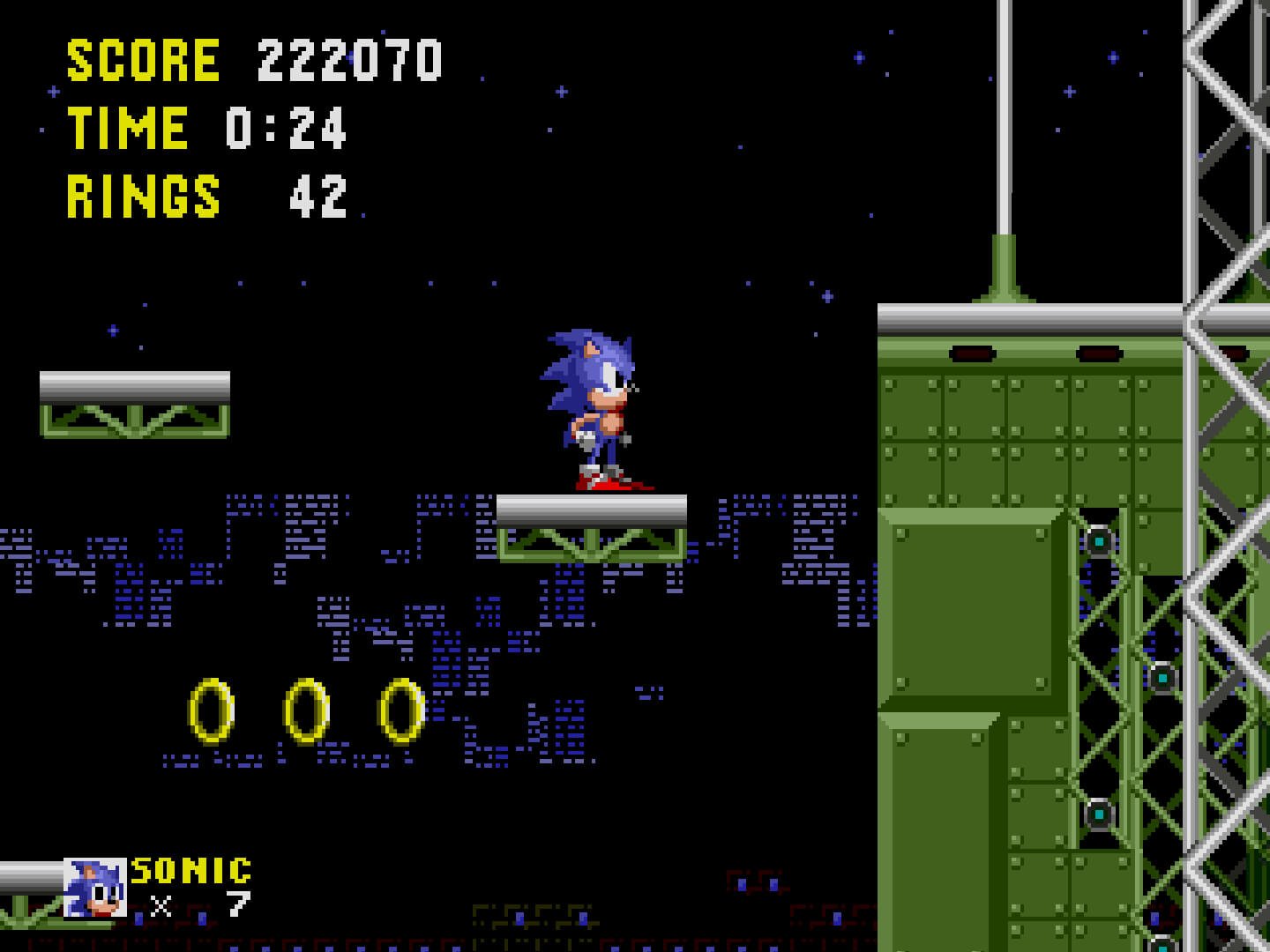

Left = Star Light Zone
Right = Scrap Brain Zone
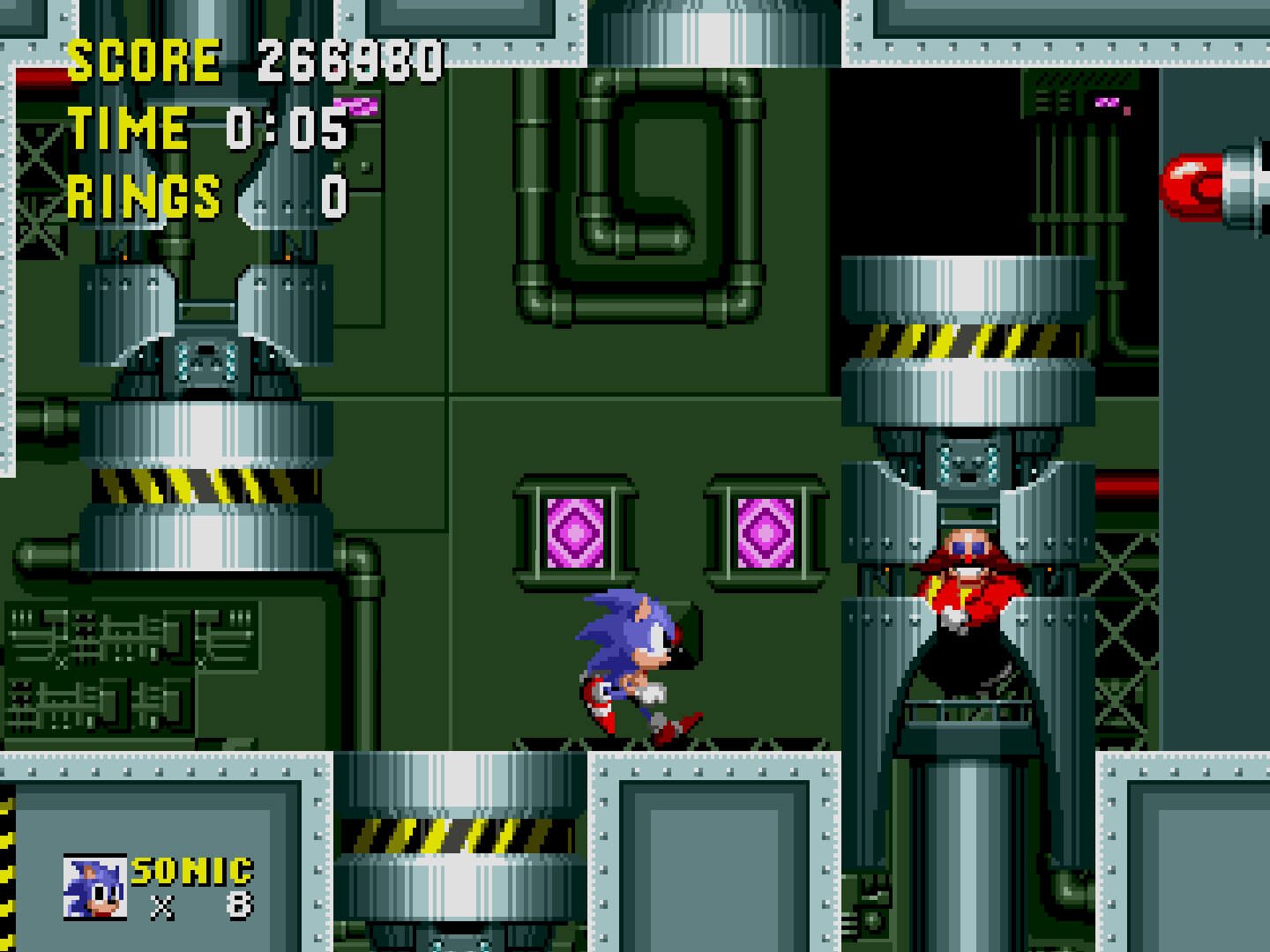
Final Zone (which uses the same background as Scrap Brain Zone Act 2)
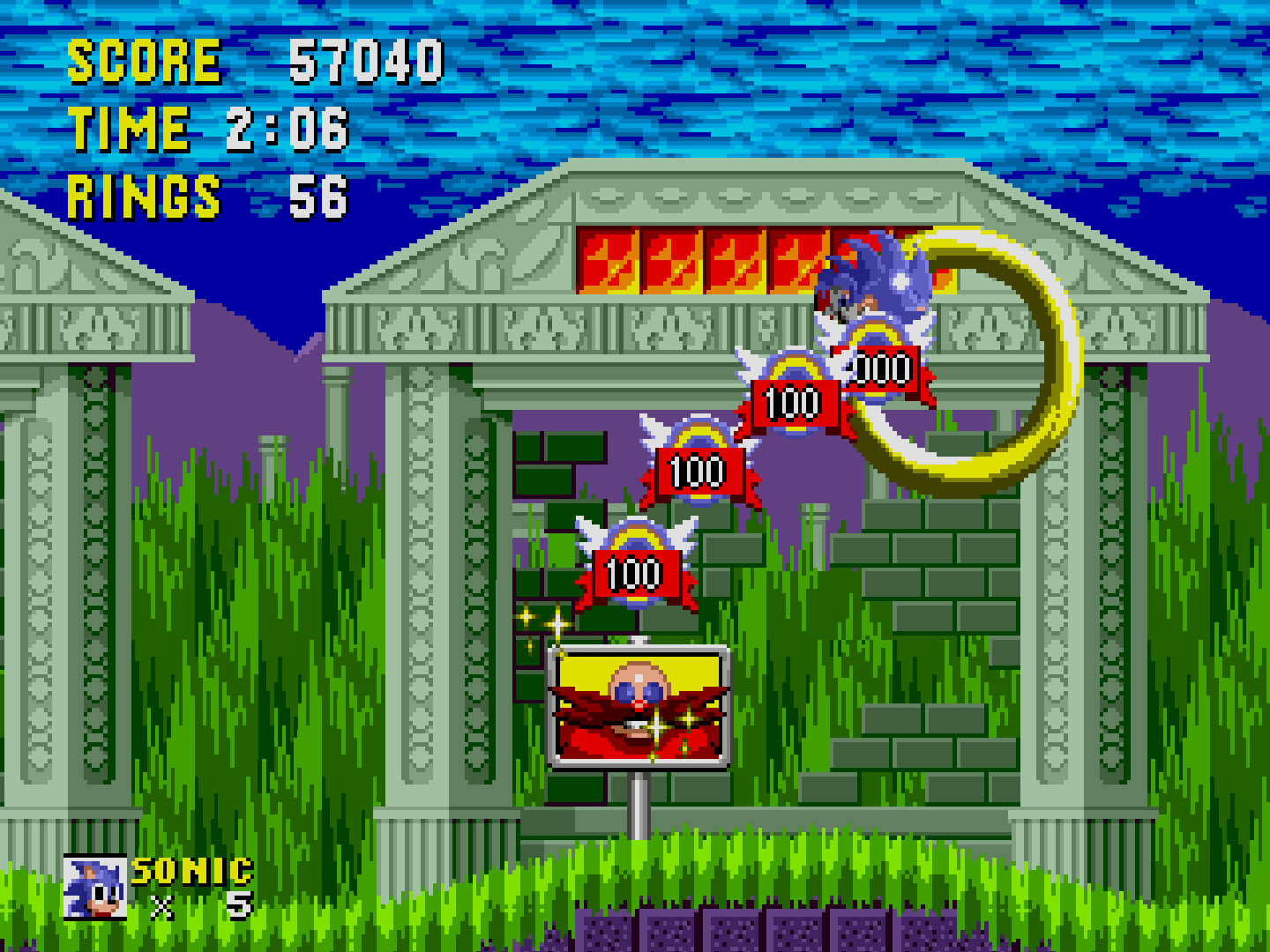
Oooh, giant ring! Don't mind if I do.
If you manage to reach the end of either Act 1 or Act 2 of any given Zone with at least 50 rings, a giant ring will appear (except in Scrap Brain Zone where giant rings won't appear at all no matter how many rings you have), and if you jump into it, you will be taken to a Special Stage. If you miss the ring, you might have a few seconds to turn back and try again, but once the "end of Act" jingle plays, you've missed your chance. You need to beat all of the Special Stages to unlock the good ending of the game.

I really should've told Sonic not to eat those mushrooms.
Special Stages place Sonic inside a rotating maze of colored blocks and circles, and a background that changes from green birds to blue fish. I'm not sure if someone at Sega was just really high when they thought of this idea for the background and the background artist either chose not to question it or was that person, but it is nonetheless very trippy. In the trailer for Sonic Superstars, we even saw this type of Special Stage return.
The way these Special Stages work is not quite as obvious as the rest of the game, but basically the maze rotates by itself and you have to find the Chaos Emerald hidden within. The emerald is buried in a group of diamonds that you remove by touching them for a few seconds (and will change color to indicate how close they are to being removed). If you grab the Chaos Emerald, you win the Special Stage.
Along the way, there are red and white circles which say UP or DOWN on them. Touching these will either increase or decrease the speed in which the maze rotates. Circles with an R on them will reverse the direction that the maze rotates. Circles with stars on them are bumpers which knock Sonic around in a direction depending on where he hits it. Blue GOAL circles will, despite what the name may suggest, send you out of the Special Stage where you will fail when touched, so it's not a goal for you. Last, but not least, are white and red circles with no words on them which don't have any special qualities. There are also rings present in the Special Stages. Collecting 50 of them will grant you a 'continue', and collecting 100 of them will grant you an extra life.
There are a total of 6 Special Stages in the game. If you fail a Special Stage, you'll move on to the next one anyway after you jump into your next giant ring, and when you visit all 6 Special Stages, any giant rings you jump into afterwards will take you back to any Special Stages that you failed previously. There are a total of 10 opportunities to grab a Chaos Emerald in the game.
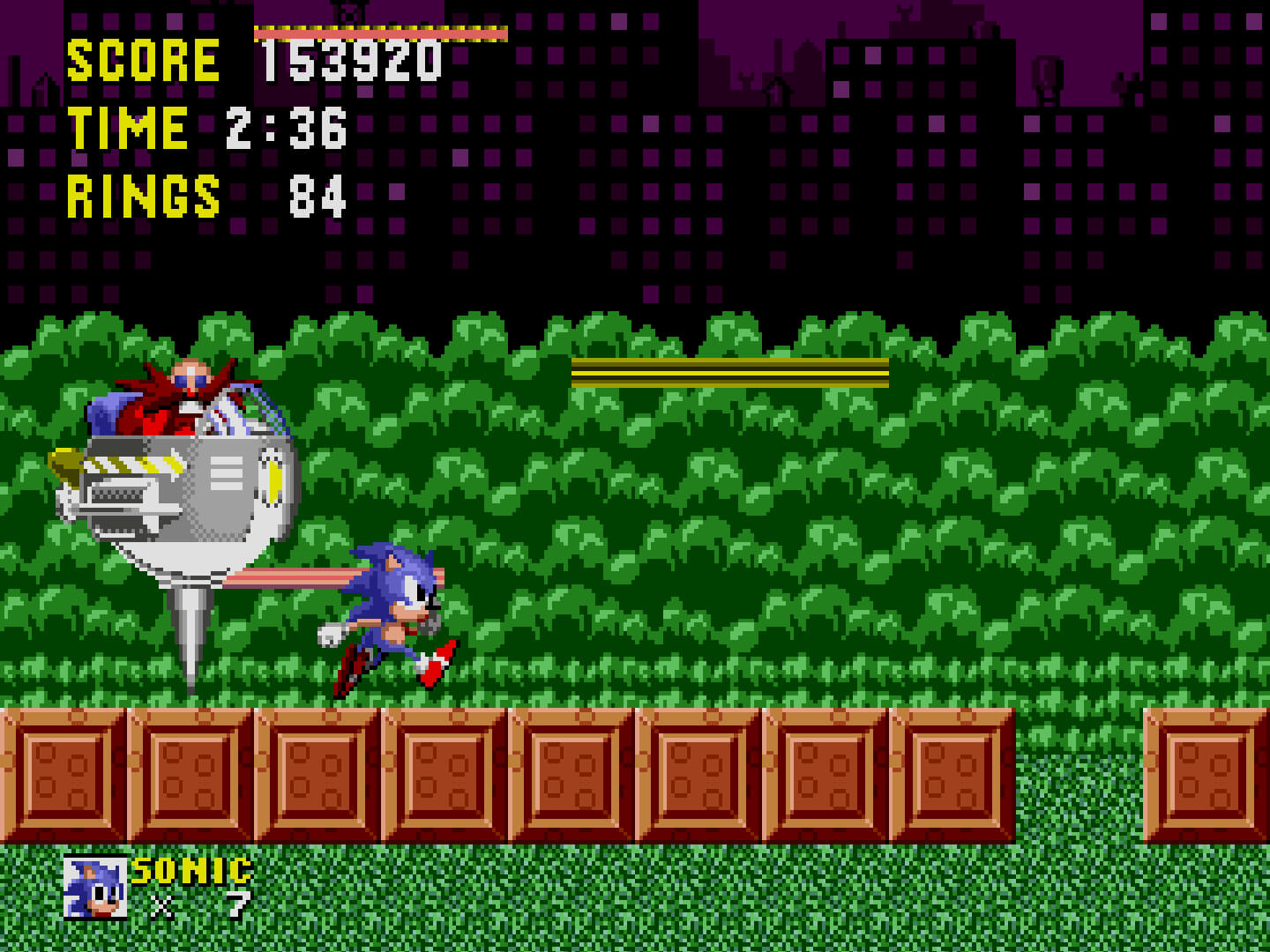
Robotnik really did not think this one through, did he?
You won't have a chance to visit a Special Stage during Act 3 though. At the end of Act 3 in every Zone (except Scrap Brain Zone), you will encounter Doctor Robotnik (or "Eggman" which was his name in Japan at the time and would become his name everywhere else in the world by the time Sonic Adventure came out) flying in his Egg-o-Matic which will initiate the boss fight of that Zone. You have to beat this to advance.
The way that each boss works (except for the boss in Labyrinth Zone) is that he'll generally have one main attack he'll perform and once you hit him 8 times, his Egg-o-Matic will be too damaged to continue the fight, leading him to quickly escape. At this point, you'll have a capsule full of animals that once you hit, will end the Act on move onto the next Zone.
Shortcomings

Fact of the day: Not only can real-life hedgehogs swim just fine, but they're actually quite good at it.
As is typical of first games in franchises, Sonic the Hedgehog 1 does have quite a bit of "first game syndrome" and some aspects of the game would either be changed or dropped entirely in later games. Although I consider myself to be pretty good at the game, it is quite difficult. It's definitely not "Nintendo hard" or anything like that, but if you're unprepared, you're going to be in for a bit of a rough time. Future installments must've taken note of this because obtaining extra lives in those games is generally easier.
If you're more familiar with other 2D Sonic games, but not so much this one, you might be a bit surprised to find out that Sonic does not have his signature Spindash move in this game. You've got to build all the momentum you need from the terrain around you. This may not sound like a big deal, and for the most part it isn't, but it does also mean that the sense of speed in the game takes a backseat a lot of the time and it also results in certain areas being more difficult to access than one might expect. When you play other 2D Sonic games and then return to this, the lack of a Spindash can give off the feeling that something is missing.
The aforementioned feeling is very noticeable. Of course Sonic is a platformer and not a racing game, so platforming is going to be present, but the game's speed drastically moves up and down very often. Whereas Green Hill Zone is a Zone where it's mostly easy to just run at top speed all the time, other Zones in the game take the pace to a crawl and sometimes outright punish you for moving too quickly, which seems to go against the nature of the series. The later classic Sonic games appear to take note of this.
This is also quite reflective in the game's length in two ways. The game only has six Zones (plus the Final Zone but for all intents and purposes, that's basically Scrap Brain Zone Act 4), but each Zone also has 3 Acts instead of 2 which would be the standard for the classic games moving forward. Most of the stages in the game are quite short as well. In general, most of them will probably take you less than 3 minutes to beat them.
One other weird quirk about the game are the spikes, and although this is technically intentional, it does get fixed in later games. Spikes both ignore invincibility frames and don't 'give' you any if you take damage from them, meaning that getting hit by something and then landing on spikes will simply cause you to die instantly most of the time. Opportunities for this to be a genuine problem are quite rare, but it will definitely come as a shock the first time it happens.
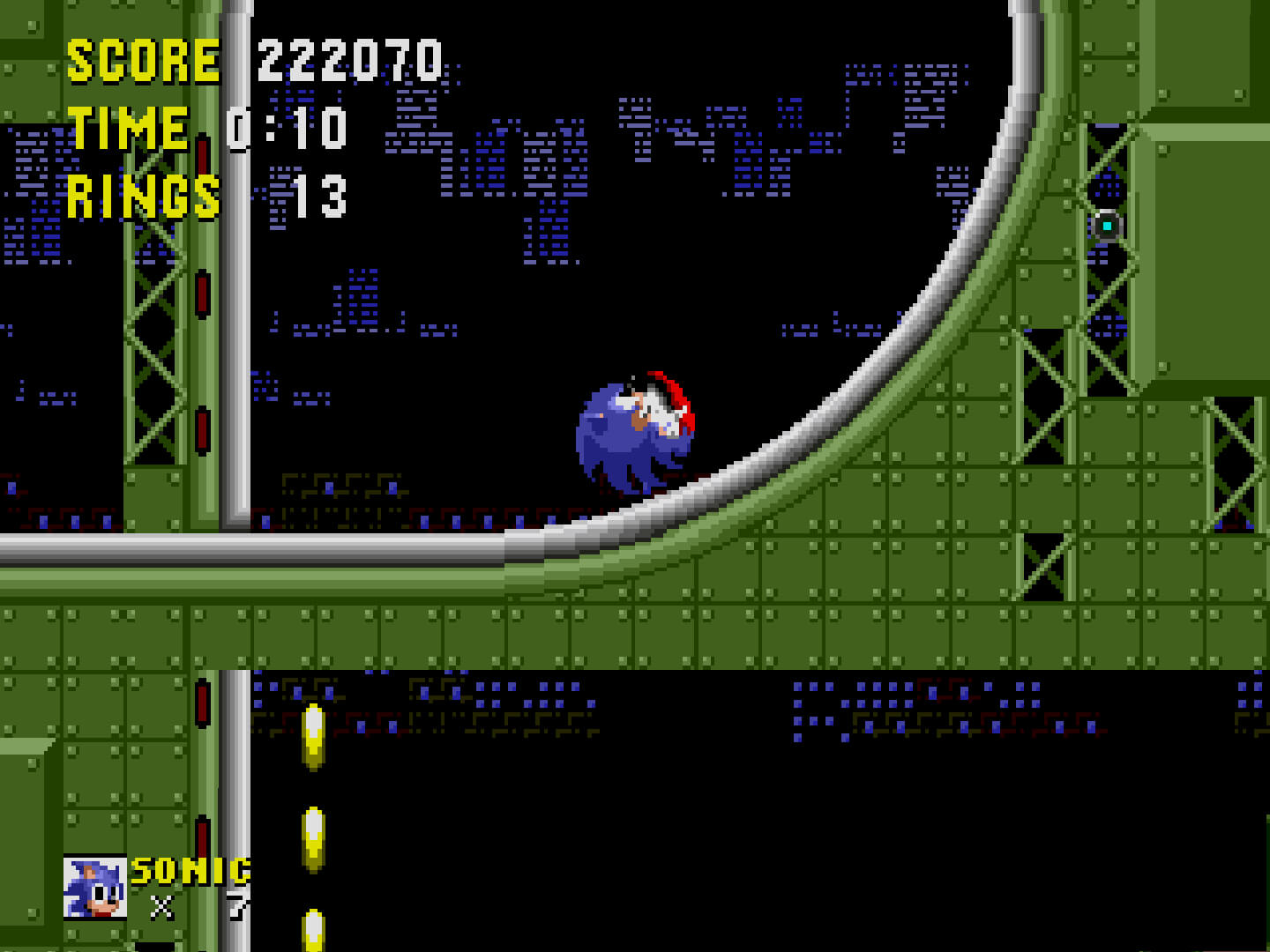
I must wonder who exactly designed this city like this. Hedgehogs?
Compared to the other Sonic games on the Genesis, it's understandable why this game doesn't tend to appear in conversation much. While it's quite common to see people who love Sonic 2 and Sonic 3 & Knuckles, the first game doesn't seem to get any attention and from playing the game, it makes sense why. Although it was established early that Sonic excels in fast-paced platforming, the game doesn't convey the same sense of fast energy that the later games would and some areas of the game seem to actively contradict the notion that Sonic is built on momentum-focused movement. Unfortunately for the first game, this feeling of missing something that makes a Sonic game into a Sonic game is hard to ignore.
Still though, the first game is an enjoyable time should you decide to pick it up. Though later games would improve upon the design philosophies of the franchise's structure, I would say that the game is worth playing even if your only interest is to just see where the iconic blue furball got his kickstart. It's a good game that would lay the groundwork for better games to come after it. In essence, this game walked so that the later Sonic games could run.

I'm sure there's no danger here. Nope, none whatsoever.
All of the Sonic games originally released on the Genesis have since been ported to future systems several times on consoles, computers, and even phones. The version I played for this article is from Steam's SEGA Mega Drive & Genesis Classics, which is a cool Genesis emulator that also doubles as a virtual collection. Unfortunately, ever since Sonic Origins was released in 2022, it is no longer possible to obtain the Sonic games for the system from there.
Sonic Origins itself has also received very lukewarm reception for many reasons. It's probably not too difficult to find a port of Sonic 1, even if it is just an emulated version of the original. Nearly every console has at least one way to play it. However you decide to play the game though, DO NOT buy the GBA version because that version is riddled with so many problems that it would take much less time to tell you what isn't wrong with it compared to what is. If you do decide to get Sonic Origins, Sonic Origins Plus just recently released which adds some extra features.
All in all, Sonic's first adventure is one that definitely shows its cracks in the ceiling, but its structural integrity manages to hold on as much as it can. Although the later Sonic games, even as far as just the Genesis is concerned, can be considered a strict upgrade over this game in many ways, Sonic 1 is a good standalone game that you'll find some enjoyment out of and I think it's a fun way to see where Sonic had its start as a mascot not just for Sega, but for gaming as a whole.
This will conclude the first of what will hopefully be many more Retrospective articles to come. What do you think about this idea for a column? Do you have any fond memories of the game? Let us know in the comments below!


Comments
Sonic the hedgehog is probably one of the prime examples of what marketing and franchising can do to build up an empire, irrespective of the result of the game (or games) of which he is based upon.
Let's be real here, the games (yes, even the good ones sonic 2 and 3) are pretty shitty. You can finish most of the levels (if not all of them) simply pressing the right button, jumping when required, and most of its enemies are completely optional, requiring almost no nonce to beat, nor offer any interesting mechanics.
I really feel the game is bogged down by the character's theme of running, making entire level designs feel more like a rube golberg machine rather than offering anything remotely interesting. Sonic isn't much a platforming game as much as it is a spectacle runner. Hence why whenever youre asked to actually play the game (like in Sonic 3d, or certain parts of sonic 2 & 3) the game falls flat.
To further illustrate my point. Playing as Tails completely invalidate entire levels. I seem to remember certain levels farcically allowing me to just fly past entire sections.
I find it funny how most people look back on the genesis age of sonic and think its gameplay still holds up. If anything, I think the game is nostalgia bait, inferior to many games Ive played as a kid on the megadrive. There are games that are great even today (like the streets of rage series), comically broken (batman forever will forever hold that throne), and then there are games that are stunningly beautiful but mechanically shallow (most disney platformers would fit in here). Sonic, however, to me is neither of those things. The sonic franchise remains alive today inspite of its games, from solid and very strong marketing, and the fact that its japanese overlords simply refuses to let the franchise die a natural death.
I grew up with sonic, love the old 90s cartoons, its ever expanding entourage of similar designed woodland creatures. But I always felt it a bit strange how so much obsession are placed in any of its games, most of which are crap.
Honestly, even as someone who enjoyed Sonic 2 when I was a child, I'm inclined to agree. Sonic in general has missed *way* more than he has hit, but Sega stubbornly refuses to let him go away. It's actually really weird, when you think about it: how many other companies have a mascot who's very popular despite the fact that so many things related to him kinda suck?